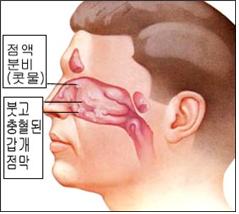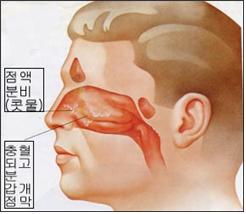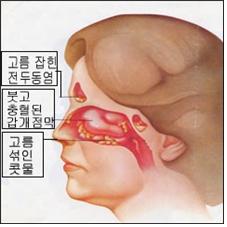코막힘 Nasal stuffing(Nasal congestion)
|
다음은 “코가 막힘, 알레르기 비염, 코가 막혀서 입으로 숨을 쉬어요”에 관한 인터넷 소아청소년 건강상담 질의응답의 예 입니다. |
Q&A. 코가 막힘, 알레르기 비염, 코가 막혀서 입으로 숨을 쉬어요
Q.
- 안녕하세요. 저는 6살, 3살 아이를 둔 엄마예요.
- 6살 딸아이가 코가 막혀서 잠을 잘 때 힘들어해요. 그리고 숨을 쉴 수가 없는지 입으로 숨을 쉬어요. 코 속에 코가 많이 들어 있어서 그런지 그럴 때는 어떻게 해야 하는지 궁금합니다.
- 그 전에 병원에 가서 물어보니 코가 코 속에서 굳어서 붙어 있다하면서 코를 녹여서 빼내는데 코 속에서 피가 나더라구요. 코 속에서 코가 굳지 않게 하려면 어떡해야 하는 지도 알려주셨으면 합니다.
A.
- 강을님
- 안녕하세요. 좋은 질문해 주셔서 감사합니다.
- 자녀의 나이 , 성별, 과거 병력, 가족 병력, 진찰소견, 임상검사 등의 정보를 많이 알수록 답변을 드리는데 도움이 됩니다. 주신 정보를 토대로 해서 답변을 드리겠습니다.
코 막힘 원인
- 감기 등 바이러스성 급성 비염,
- 만성 비염,
- 위축성성 비염,
- 부비동염,
- 알레르기 비염,
- 비강 내 이물,
- 코의 선천성 기형,
- 후천성 코 변형,
- 아데노이드 비대,
- 비용(비 폴립),
- 약물 알레르기,
- 음식물 알레르기,
- 혈관 운동성 비염,
- 코 종양
- 또는 악성 종양,
- 코의 외상,
- 공해,
- 갑상선 이상 등으로 코가 막힐 수 있습니다.
코 막힘 치료
- 우선 원인을 알고 그 원인에 따라 치료해야 합니다.
- 코 속에 비강 분비물(콧물)이 말라서 코가 막힐 수 있지만 그런 것으로 코가 막혀 숨을 못 쉬는 경우는 아주 드뭅니다.
- 만일 그렇다면 그 원인을 알아 그 원인되는 병을 치료해야 합니다.
- 알레르기 비염이나 감기로 비강의 점막층이 부어서 코가 막힐 수 있습니다. 이런 때는 비강 점막 충혈 완화제로 대증치료를 할 수 있습니다.
- 경구용 2세대 항히스타민, 코르티코스테로이드제 코 분무로 치료할 수 있습니다.
- 만약 박테리아 부비동염을 의심하면 경구용 항생제로 치료해도 됩니다.
- 이런 치료는 어디까지나 의사에게 맡겨야 합니다.
- 큰 아이들에게 콧물이 많이 나올 때는 코를 살살 풀고 닦아도 됩니다.
- 자녀의 경우는 알레르기 비염으로 그런 증상이 생기는 것 같습니다.
- 소아청소년과에서 진찰 진단을 받으시고 그 원인에 따라서 치료해 주시기 바랍니다.
- [부모도 반의사가 되어야 한다–소아가정간호백과]-제8권 소아청소년 호흡기 질환–감기, 제15권 소아 청소년 알레르기 및 자가 면역질환–알레르기 비염
- 부비동염 등을 참조하시기 바랍니다.
- 특히 제3권 신생아, 영유아, 학령기 아이 사춘기 아이 성장발육-“신생아–코“란 주제를 참고하시기 바랍니다. 그리고 질문이 더 있으시면 다시 연락해 주시기 바랍니다. 감사합니다. 이상원 드림
|
다음은“아기의 장기비행 ”에 관한 인터넷 소아청소년 건강상담 질의응답의 예 입니다. |
Q&A. 아기의 장기비행
Q.
- 이건 제가 여행준비를 하며 간호사로부터 도움말을 들은 거예요.
- 비행기가 이륙 착륙할 때 특히나 어른들도 고막에 이상한 증상을 느끼게 되잖아요. 그런 증상 때문에 혹시나 아기가 짜증이 나서 울 수도 있다고 하면서 이착륙을 할 때 아기에게 우유 같은 음료수를 먹이면 자연스럽게 아기가 삼키면서 귀를 뚫게 되니까 그것이 도움이 될 거라고 그랬어요.
- 저는 짧은 여행이었기 때문에 그리 큰 문제는 없었고 아기도 걱정한 것만큼 비행기가 착륙할 때 힘들어 하지 않았어요.
- 긴여행이라걱정이되시겠지만의사선생님답변되로준비를하시면 도움이 많이 될 거예요.
A.
- 진이님
- 안녕하세요. 감사합니다.
- 글쎄요.
- 생후 2개월 영아들을 데리고 비행기로 장거리 여행을 하는 중 이착륙 할 때 중이, 고막, 우유(우유는 2개월 전 영유아들에게 먹여서는 안 되는 음식물이지만) 먹임, 귀 아픔에 관한 연구문헌을 읽어본 적도 없고 그런 문헌은 없다고 믿습니다.
- 가능하면 2개월 된 영아를 데리고 비행기 여행을 하지 않는 것이 좋다고 생각합니다.
- 비행기가 이착륙할 때 아데노이드, 비강 점막, 비강 점막층, 연구개, 인두강, 구씨관(이관), 중이강, 외이도 등 상기도 기도 부분의 여러 기관이 상호 협력해 중이강 내 압, 구강내 압, 인두강 내 압, 비강내 압, 외이도 내 압 등이 적절히 조절되어 고막, 중이강 등이 그때그때의 기내 압에 적응하는 것이 정상입니다.
- 이러한 상황에서 “우유“를 먹이는 것이 얼마나 도움이 될지 의심이 갑니다.
- 그리고 먹는 인공영양이 이관을 통해서 중이강 속으로 들어가 중이염을 일으킬 수 있을 것입니다.
- 비행기 이착륙을 할 때 성인들이 껌을 씹으면 고막이 덜 아플 수 있다고 합니다.
- 이착륙을 할 때 여유아들은 고무젖꼭지를 빨면 고막이 덜 아플 수 있을 것 같습니다.
- 또 2개월 된 영아에게 인공영양을 수유할 시간이나 모유를 수유하는 시간은 어느 정도 정해져 있는데 비행기 이착륙 시간에 맞춰 영유아에게 수유하는 것도 상당히 어려울 것입니다.
- 정확한 비행기 이착륙 시간과 이착륙하는 기간을 확실히 알기 어렵습니다. 어느 때에 얼마동안 수유를 해야 하는 것도 문제입니다.
- 먹일 때도 안 된 영아에게 억지로 인공영양을 먹여 과식하면 구토할 수 있고 모유 수유하는 아기에게 모유수유를 이착륙할 때 계속 오랫동안 준다는 것도 때로는 불편한 것입니다.
- 비행기 여행하는 성인들에게 이착륙할 때 껌을 씹으라고 권장하지만 그것도 실용적인 것은 아닙니다.
- 아직까지 일반적인 비행기 여행을 할 때 고막이 뚫리거나 아파서 비행기를 더 이상 타지 못하겠다고 하는 성인들이나 이이들을 본적이 한 번도 없습니다.
- 이착륙할 때 노리개 젖꼭지를 물려주면 도움이 될까 생각도 해보지만……
- 저는 영유아들과 비행기로 여행하는 부모님들께 고막이 아픈 것에 대해 걱정하시지 말고 즐겁게 여행을 하시라고 권합니다.
- 우유를 먹이라고 권장했을 때 우유를 안 먹으면 어머님께서 또 한 번 걱정을 할 것입니다. 질문이 더 있으면 다시 연락해 주시기 바랍니다. 감사합니다. 이상원 드림

그림 166. 알레르기 비염으로 비강 점막층이 붓고 창백하고 점액이 나오고 콧물이 나온다. 그로 코가 막힐 수 있다.출처;Used with permission from Schering Corporation, Kenilworth, N.J. USA

그림 167. 감기 등 급성 비염 또는 만성 비염으로 콧물이 나고 코가 막힐 수 있다.
출처; Used with permission from Schering Corporation, Kenilworth, N.J. USA

그림 168. 급성 부비동염 또는 만성 부비동염이 있을 때 콧물이 나올 수 있고 코가 막힐 수 있다.Copyright ⓒ 2011 John Sangwon Lee, M.D., FAAP
Nasal stuffing (Nasal congestion) 코막힘
The following is an example of Internet pediatric health counseling Q&A regarding “stuffy nose, allergic rhinitis, stuffy nose and mouth breathing”.
Q&A.
stuffy nose, allergic rhinitis, stuffy nose, breathing through mouth
Q.
• Good morning. I am a mother of 6 and 3 year old children.
• My 6 year old daughter has a stuffy nose and is having trouble sleeping. And she breathes through her mouth to see if she can’t breathe. I have a lot of nose in my nose, so I wonder what to do when that happens.
• Before that, when I went to the hospital and asked if the nose was stuck in the nose, I melted the nose and took it out, but there was blood in the nose. I want you to tell me what to do to keep my nose from getting stuck in my nose.
A.
• Eul-nim Kang
• Good morning. Thanks for the nice question.
• The more information you know about your child’s age, gender, past medical history, family history, examination findings, and clinical tests, the more helpful it is to give you an answer. We will give you an answer based on the information you provided.
Causes of a stuffy nose
• Acute viral rhinitis, such as a cold;
• chronic rhinitis;
• atrophic rhinitis;
• Sinusitis;
• allergic rhinitis;
• foreign body in the nasal cavity;
• Congenital malformations of the nose;
• Acquired nasal deformity;
• Adenoid hypertrophy,
• cost (non-polyps);
• drug allergies;
• food allergies;
• vasomotor rhinitis,
• Nasal Tumors
• or malignant tumors;
• trauma to the nose;
• Pollution,
• Your nose may be blocked due to abnormalities in the thyroid gland.
Nasal congestion treatment
• First you need to know the cause and treat it accordingly.
• Nasal secretions (runny nose) in the nose can dry out and cause a stuffy nose, but it is very rare that such a stuffy nose makes it difficult to breathe.
• If so, you need to find out the cause and treat the disease that is causing it.
• Allergic rhinitis or a cold can cause the nasal mucosa to swell and become stuffy. In this case, symptomatic treatment can be done with nasal mucosal decongestants.
• Can be treated with oral second-generation antihistamines, corticosteroids and nasal sprays.
• If bacterial sinusitis is suspected, it may be treated with oral antibiotics.
• This treatment should be left to your doctor.
• When older children have a lot of runny nose, it is okay to gently blow and wipe their nose.
• In your child’s case, it seems that allergic rhinitis is causing these symptoms.
• Please receive a diagnosis from the Department of Pediatrics and treat it according to the cause.
•www.drleepediatrics.com – Volume 8 Respiratory Diseases in Children and Adolescents – Colds, Volume 15 Allergy and Autoimmune Diseases in Children and Adolescents – Allergic Rhinitis • See also Sinusitis.
• In particular, please refer to the topic of Volume 3, Newborns, Infants, School-age Children, Adolescent Child Growth-“Newborn-Nose”. And if you have any more questions, please feel free to contact us again. Thank you. Lee Sang-won.MD
The following is an example of a Q&A on health counseling for children and adolescents on the Internet about “Baby’s long-term flight”.
Q&A. baby’s long flight
Q.
• This is what I was getting ready for my trip and I got some advice from the nurse.
• When airplanes take off and land, especially adults, they feel strange symptoms in their eardrums. He said that the baby might cry because of these symptoms, and that it would be helpful because if you give the baby a drink like milk during takeoff and landing, the baby will naturally swallow and pierce the ears.
• It was a short trip so it wasn’t too much of a problem for me, and the plane landing wasn’t as hard as my baby was worried about.
• You may be worried because it is a long trip, but as the doctor answered, it will be of great help if you prepare
. A.
• Mr. Jin
• Good morning. Thank you.
• I do not know.
• I have read research literature on middle ear, eardrum, milk (milk is a food that should not be given to infants 2 months old), and ear pain during take-off and landing during long-distance travel by plane with 2-month-old infants. I believe there is no such document.
• If possible, we recommend that you avoid air travel with a 2-month-old infant. • When airplanes take off and land, various organs in the upper airway, such as adenoids, nasal mucosa, nasal mucosa, soft palate, pharyngeal cavity, bulbar tube (ear tube), middle ear cavity, and external auditory meatus, cooperate with each other to cooperate with the middle ear pressure, intraoral pressure, and pharynx. It is normal for the tympanic membrane and middle ear cavity to adapt to the in-flight pressure at each time by properly regulating intracavitary pressure, intranasal pressure, and pressure in the external auditory meatus.
• I doubt how helpful “milk” feeding would be in this situation.
• And artificial nutrition you eat may enter the middle ear cavity through the ear canal and cause otitis media.
• Adults say that chewing gum during takeoff and landing can reduce eardrum pain. • It seems that the eardrum hurts less if the baby boy sucks on pacifiers during takeoff and landing.
• Also, the time for feeding or breastfeeding a 2-month-old infant is set to some extent, but it will be quite difficult to feed the infant at the time of takeoff and landing of the plane.
• It is difficult to know with certainty the exact time of takeoff and landing of an airplane and the duration of takeoff and landing. It is also a matter of when and for how long to breastfeed.
• Forcibly feeding an unfed infant with artificial nutrition can cause vomiting if overeating, and it is sometimes inconvenient to continue to give breastfeeding to a breastfeeding baby during take-off and landing for a long time.
• Adults traveling by plane are encouraged to chew gum during takeoff and landing, but that is not practical.
• I’ve never seen or seen adults who say they won’t be able to fly because their eardrums are punctured or sick during normal air travel.
• I wondered if it would be helpful if I gave a soother pacifier during takeoff and landing… … • I recommend to parents traveling by plane with young children, don’t worry about your eardrums hurting, and enjoy your trip.
• If you do not drink milk when recommended to feed, your mother will worry again. If you have any more questions, please contact us again.
Thank you. Lee Sang-won.MD

Figure 166. With allergic rhinitis, the nasal mucosa is swollen, pale, with mucus and runny nose. It can lead to stuffy nose. Source; Used with permission from Schering Corporation, Kenilworth, N.J. USA

Figure 167. Acute rhinitis such as a cold or chronic rhinitis can cause runny nose and stuffy nose. source; Used with permission from Schering Corporation, Kenilworth, N.J. USA

Figure 168. A runny nose and stuffy nose may occur in acute sinusitis or chronic sinusitis. Copyright ⓒ 2011 John Sangwon Lee, M.D., FAAP
출처 및 참조 문헌 Sources and references
- NelsonTextbook of Pediatrics 22ND Ed
- The Harriet Lane Handbook 22ND Ed
- Growth and development of the children
- Red Book 32nd Ed 2021-2024
- Neonatal Resuscitation, American Academy of Pediatrics
- www.drleepediatrics.com 제 6권 신생아 성장 발육 육아 질병
-
www.drleepediatrics.com제7권 소아청소년 감염병
- www.drleepediatrics.com제8권 소아청소년 호흡기 질환
- www.drleepediatrics.com제9권 소아청소년 소화기 질환
- www.drleepediatrics.com제10권. 소아청소년 신장 비뇨 생식기 질환
- www.drleepediatrics.com제11권. 소아청소년 심장 혈관계 질환
- www.drleepediatrics.com제12권. 소아청소년 신경 정신 질환, 행동 수면 문제
- www.drleepediatrics.com제13권. 소아청소년 혈액, 림프, 종양 질환
- www.drleepediatrics.com제14권. 소아청소년 내분비, 유전, 염색체, 대사, 희귀병
- www.drleepediatrics.com제15권. 소아청소년 알레르기, 자가 면역질환
- www.drleepediatrics.com제17권. 소아청소년 피부 질환
- www.drleepediatrics.com제18권. 소아청소년 이비인후(귀 코 인두 후두) 질환
- Red book 29th-31st edition 2021
- Nelson Text Book of Pediatrics 19th — 21st Edition
- The Johns Hopkins Hospital, The Harriet Lane Handbook, 22nd edition
-
Childhood Emergencies in the Office, Hospital and Community, American Academy of Pediatrics
-
Emergency Medical Service for Children, By Ross Lab. May 1989. p.10
-
Emergency care, Harvey grant, and Robert Murray
-
Emergency Care Transportation of Sick and Injured American Academy of Orthopaedic Surgeons
-
Emergency Pediatrics A Guide to Ambulatory Care, Roger M. Barkin, Peter Rosen
-
Immediate care of the acutely ill and injured, Hugh E. Stephenson, Jr
-
The Critically Ill Child, Diagnosis and Management, Edited by Clement A. Smith
-
Emergency Medical Services for Children: The Role of the Primary Care Provider, America Academy of Pediatrics
-
Quick Reference To Pediatric Emergencies, Delmer J. Pascoe, M.D., Moses Grossman, M.D. with 26 contributors
-
Manual of Emergency Care
-
응급환자관리 정담미디어
-
소아가정간호백과–부모도 반의사가 되어야 한다, 이상원
-
Neonatal Resuscitation American heart Association
-
Neonatology Jeffrey J.Pomerance, C. Joan Richardson
-
Pediatric Resuscitation Pediatric Clinics of North America, Stephen M. Schexnayder, M.D.
-
Pediatric Critical Care, Pediatric Clinics of North America, James P. Orlowski, M.D.
-
Preparation for Birth. Beverly Savage and Dianna Smith
- Infectious disease of children, Saul Krugman, Samuel L Katz, Ann A. Gershon, Catherine Wilfert
-
The Harriet Lane Handbook 19th Edition
-
소아과학 대한교과서
-
제1권 소아청소년 응급의료 참조문헌과 출처
-
Other
Copyright ⓒ 2015 John Sangwon Lee, MD., FAAP
“부모도 반의사가 되어야 한다”-내용은 여러분들의 의사로부터 얻은 정보와 진료를 대신할 수 없습니다.
“The information contained in this publication should not be used as a substitute for the medical care and advice of your doctor. There may be variations in treatment that your doctor may recommend based on individual facts and circumstances. “Parental education is the best medicine.”